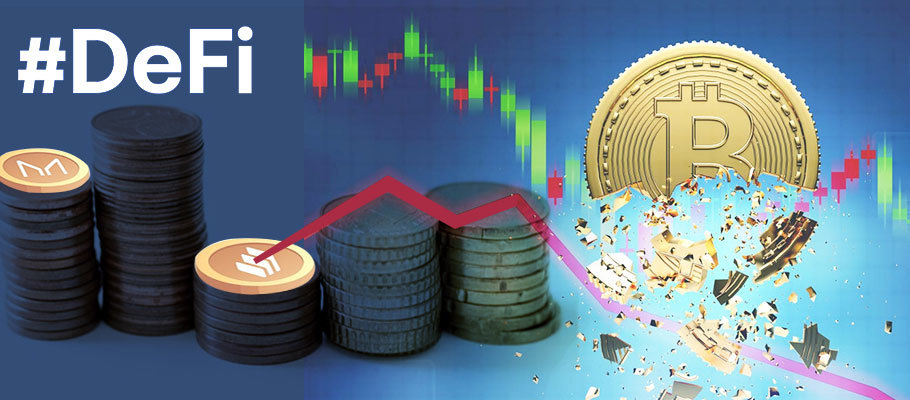
Published: September 10th, 2021
Decentralised finance (DeFi) tokens have been the worst casualties of this week’s marketwide crypto correction.
While the DeFi sector has seen impressive, even remarkable, growth in the last 12 months, not even blue-chip projects like Uniswap, Aave, and Chainlink were shielded from the carnage. Numbers from CoinGecko show they all suffered drops of 20 per cent or more, in some cases literally overnight.
That means they fell harder than either bitcoin or ethereum, which have drawn the most media attention during the rout.
DeFi businesses offer traditional financial services like lending and borrowing but in a decentralised format. Buyers and sellers transact peer-to-peer, e.g. without the need for a middleman like an exchange or broker.
At the start of the week, the global cryptocurrency market was in a bullish mood. Bitcoin (BTC) hovered around USD 52,500 while ethereum (ETH) nearly touched its peak high of USD 4,000.
Then El Salvador officially became the first country to make Bitcoin legal tender on Tuesday, though it didn’t deliver the uplift crypto fans expected.
Then on Wednesday came the crash, a sudden 13 per cent drop in the total market capitalisation for cryptocurrencies, followed by 11 per cent and 15 per cent losses for BTC and ETH, in a matter of hours.
DeFi token holders fared even worse:
Looking across the broader DeFi market, in the top ten DeFi tokens by market cap, Pancake Swap rapidly shed 17.3 per cent of its value, while Terra depreciated by 8.2 per cent.
With the global crypto market cap down by nearly 10 per cent at the time of writing, double-digit losses have been almost ubiquitous among DeFi tokens. Analysts are still trying to unpick what happened and why DeFi has been hit particularly hard.
Finance and business publications have been jam-packed with bad news for crypto traders after a period where prices rose across the board after a previous steep correction in May.
What the headlines don't explain, however, is what’s behind the latest crash in crypto prices. The overall market has been buoyant, with outlandish NFT auctions and bitcoin becoming legal tender for the first time.
Analysts at Arcane Research told Bloomberg that massive stories like Mutant Ape and El Salvador are sometimes over-emphasised by markets when pricing in the impact. 'That seems to have been the case this past month.’
It seems crypto traders over-shot the mark when they bet on future prices. On the day El Salvador announced in June that a bill was making its way through parliament to codify Bitcoin as legal tender, BTC was trading at USD 38,000. In the three plus months since then, BTC’s price has risen steadily back up to USD 52,000.
The Salvadoran bill was enacted and went into effect this past Tuesday. Yet, the event didn't deliver the expected result. Bitcoin's price dipped, a perfect example of the old financial truism: ‘buy on the rumour, but sell on the news.’
Arcane’s analysts say the drop was aggravated by too many over-leveraged positions. On Bybit, for example, 100x leverage is available for risk-hungry crypto traders. That means a trader could open a trade of 10 Bitcoin, for instance, while only having to deposit a tenth of a Bitcoin upfront in their trading account.
Leverage is great when markets are on the up. It enables speculation and widens the pool of investors who can potentially benefit from bull markets. But when markets tank, leveraged trades are the first to be liquidated. And they can cause severe losses. The more leverage a trader has taken on, the smaller the price drop required for the exchange to trigger a position close. They grab whatever coins are available and tend to act fast to stem further losses.
When BTC and ETH began to dip at mid-week, it set off a cascade of liquidations of long positions. A snowball effect then took hold when more people were prompted to sell. That triggered more liquidations, which convinced more people to sell, and so on.
That explains what happened with the biggest crypto assets, but what about other coins and DeFi tokens?
Arcane’s analysts blame an 'overly bullish buy-up of altcoins in August as a contributing factor in the widening market chaos. The bad news has effectively rolled downhill to impact DeFi tokens too.
Altcoins have had a blazing good run. Cardano saw its price rise by 60 per cent since the start of August. XRP is still up 32 per cent for the month, even after taking a 20 per cent hit in this week’s carnage. Binance Coin, meanwhile, lost nearly 20 per cent on Wednesday but still managed to hold on to a 15 per cent increase in its price compared to 30 days ago.
Contrast those results with the crypto ‘majors.’ Data from Bybt shows that USD 1.5 billion in Bitcoin was liquidated between Wednesday and Thursday this week. At the same time, ETH saw USD 900 million in liquidations.
Perhaps the story to watch amid all the mayhem is the crypto top 10’s sole bright spot: Solana. SOL’s price continues to set new all-time highs from week to week, even flipping XRP to become the sixth-largest crypto by market cap. Users and DeFi projects have flocked to the smart contract-enabled network thanks to fast transaction speeds and lower transaction fees.
Though DeFi’s first wave has happened mainly on Ethereum, Solana is challenging to become the DeFi and NFT platform of choice.